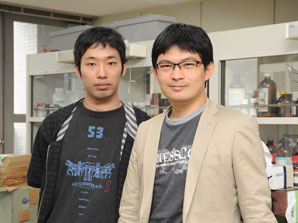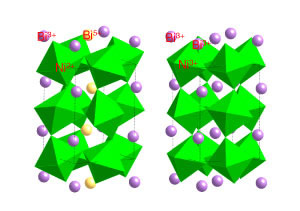Research Group of Shimakawa lab, “Colossal Negative Thermal Expansion in BiNiO3 Induced by Intermetallic Charge Transfer” (Published in Nature Communications, 14 June 2011)
|
Colossal Negative Thermal Expansion in BiNiO3 Induced by Intermetallic Charge Transfer
Published in Nature Communications (Online Publication, June 14, 2011). |

Dr. W. T. Chen (right) and Mr. H. Seki (left), who conducted the main experiments in this study. |
| Dr. M. Azuma (presently, Prof. in Tokyo Institute of Technology), Dr. W. T. Chen (Research Associate), Mr. H. Seki (Master course student), Mr. Michal Czapski (Alumni), Dr. S. Olga (former Research Associate), Dr. K. Oka (presently, Assist. Prof. in Tokyo Institute of Technology), Dr. S. Ishiwata (presently, Assoc. Prof. in Tokyo University) and Dr. Y. Shimakawa (Prof.) in Advanced Solid State Chemistry Laboratory found colossal negative thermal expansion in BiNiO3 induced by intermetallic charge transfer. | |
|
The unusual property of negative thermal expansion is of fundamental interest and may be used to fabricate composites with zero or other controlled thermal expansion values. Here we report that colossal negative thermal expansion (defined as linear expansion < -10-4 K-1 over a temperature range ~100 K) is accessible in perovskite oxides showing charge-transfer transitions. BiNiO3 shows a 2.6% volume reduction under pressure due to a Bi/Ni charge transfer that is shifted to ambient pressure through lanthanum substitution for Bi. Changing proportions of coexisting low- and high-temperature phases leads to the smooth volume shrinkage on heating. The crystallographic linear expansion coefficient for Bi0.95La0.05NiO3 is -137×10-6 K-1 and a value of -82×10-6 K-1 is observed between 320 and 380 K from a dilatometric measurement on a ceramic pellet. Colossal negative thermal expansion materials operating at ambient conditions may also be accessible through metal-insulator transitions driven by other phenomena such as ferroelectric orders. |
|

|
Crystal structures of BiNiO3 at low pressure and temperature (left) and high pressure and temperature (right). |
| The research was done in collaboration with Drs. M. Mizumaki and N. Kawamura in Japan Synchrotron Radiation Research Institute, T. Watanuki in Japan Atomic Energy Agency, N. Ishimatsu (Assis. Prof.) in Hiroshima University, M. G. Tucker in Rutherford Appleton Laboratory, UK, & J. Paul Attfield (Prof.) in University of Edinburgh, UK. | |
 Institute for Chemical Research, Kyoto University
Institute for Chemical Research, Kyoto University International Joint Usage Research Center
International Joint Usage Research Center